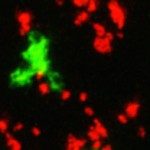Link to Pubmed [PMID] – 16607556
Planta 2006 Sep;224(4):812-27
In order to evaluate the permanent chromatin remodeling in plant allowing their high developmental plasticity, three sugarbeet cell lines (Beta vulgaris L. altissima) originating from the same mother plant and exhibiting graduate states of differentiation were analyzed. Cell differentiation has been estimated by the cell redox state characterized by 36 biochemical parameters as reactive oxygen species steady-state levels, peroxidation product contents and enzymatic or non-enzymatic protective systems. Chromatin remodeling has been estimated by the measurement of levels of DNA methylation, histone acetylation and corresponding enzyme activities that were shown to differ between cell lines. Furthermore, distinct loci related to proteins involved in cell cycle, gene expression regulation and cell redox state were shown by restriction landmark genome scanning or bisulfite sequencing to display differential methylation states in relation to the morphogenic capacity of the lines. DNA methylating, demethylating and/or histone acetylating treatments allowed to generate a collection of sugarbeet cell lines differing by their phenotypes (from organogenic to dedifferentiated), methylcytosine percentages (from 15.0 to 43.5%) and acetylated histone ratios (from 0.37 to 0.52). Correlations between methylcytosine or acetylated histone contents and levels of various parameters (23 or 7, respectively, out of 36) of the cell redox state could be established. These data lead to the identification of biomarkers of sugarbeet morphogenesis in vitro under epigenetic regulation and provide evidence for a connection between plant morphogenesis in vitro, cell redox state and epigenetic mechanisms.

